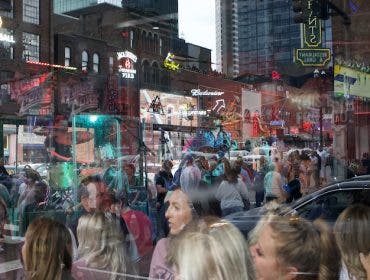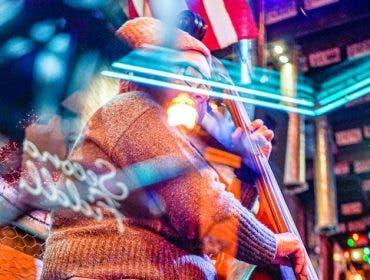Before graffiti (or street art) photography was widely appreciated by onlookers and practiced by underground artists around the world, it was considered simple and thoughtless vandalism. Fortunately, majority of the world has caught on and taken notice of the beauty of these meaningful pieces of art often found on the walls of our neighborhoods.
For many street photographers, graffiti changed the way photographers compose photos. With an interesting new background for their images, they’ve started paying more attention to that element in the frame instead of just focusing on their subjects, thus creating more creative opportunities for each shot.
In this article, we’ll provide you with some helpful tips on how you can use these unique scribblings and paintings to improve your images when doing street photography.
How Graffiti Art Can Improve Street Photography

Colorful street art is often best observed in person, but more and more people are featuring it in photos and showing it off to wider audiences. But while this provides graffiti artists with the benefit of gaining more exposure, it also offers a great benefit for street photographers as it can improve their images in the following ways:
Provides an interesting backdrop for portraits
Graffiti is typically made of colorful patterns, designs, lines, shapes, and more. Therefore, when you get tired of those dull sidewalks and roads, graffiti walls can also serve as a good background for shooting portraits of people.
Serves as a compelling subject in itself
Apart from just looking aesthetically pleasing, graffiti art is also filled with meaning—just like any other type of artwork. This makes it an interesting photography subject all on its own, even without adding a focal subject such as a person or an animal.
Gives your images a grungy look
Graffiti often lends a grungy “street” feel to your photos. Street photography is all about showing beautifully gritty scenes and subjects, and including graffiti artwork in your images allows you to do that with minimal effort.
Shows the personality or quirks of a neighborhood
Graffiti art is usually reflective of the personality of the neighborhood where it is located. Thus, including it in your photos can give your viewers a look into the culture of the place and what it may be like to be in that particular setting.
8 Tips for Shooting Street Artwork

Now that you’re convinced that graffiti art can significantly improve your street photography, here are a few technical tips to help to capture and utilize them well in your future images.
- Do Your Research
- Pay Attention to the Weather
- Pick the Right Time of Day
- Incorporate Other Elements Into the Frame
- Capture the Real Essence of the Graffiti Art
- Use a Wide-Angle Lens
- Include People in the Frame
- Use HDR When Shooting Graffiti
Do Your Research

Obviously, the first thing you need to do is find out where you can find some good graffiti art. Do you research and find out all about the graffiti art spots in the area so you can check them out and plan where you want to shoot (and note that, yes, they might change and be repainted with little or no notice). Go online and search for any graffiti art that may have been featured by other photographers previously, and see if you can obtain the exact location of any specific ones that you want to photograph. Or you can simply visit some of the more urban areas in a city or neighborhood to find some graffiti—but preferably with a friend in tow, as these places can sometimes be unsafe, especially for someone carrying expensive camera equipment.
Pay Attention to the Weather

The right weather can enhance the graffiti art you decide to feature, so you have to be aware of the weather on the day you plan to shoot. Decide whether a particular street art looks better under cloudy, rainy, or sunny weather, and consult the week’s weather calendar when planning your shoot. This enables you to add variety to your graffiti photography and give it a particular feel.
Pick the Right Time of Day

Make sure to pick the right time to take photos. Shooting during a specific time of day will yield different outcomes, so consider the look you want to achieve and pick the best time of day to capture it.
Depending on your personal judgment and composition, you may need to take pictures of the art during the day when there’s more natural light, or at night when street lamps are your only light source. You have the option to use an external flash, but may need to plan how you’re going to provide equal or selective lighting to the artwork, depending on its size and how much of it you want to capture.
Incorporate Other Elements Into the Frame

Despite the graffiti being art in itself, its surroundings are sometimes essential in giving more context to your work. When composing your street art photo, look for complementary or contrasting elements that support the story you want to tell, and include them in the frame. It’s not always a requirement, but keep this in mind as there are sure to be certain scenarios wherein some additional elements can help make your composition more interesting and engaging for your viewers.
Capture the Essence of the Graffiti Art

Almost every street art has a message, meaning, or idea behind it. This is why it has served as a popular way for many artists to support the public in expressing (often political) protest and social commentary. As a street photographer, you have the opportunity to understand and share the message behind it through your images.
Use a Wide-Angle Lens

Graffiti art comes in different sizes. Some are small, while others can take up an entire wall that spans several feet, or several dozen feet. Due to this, make sure to have a wide-angle lens on hand so you can capture more of the art in a single frame. This will help show scale and allow your audience to gauge how big the work is while preserving the intricate details that make up the graffiti.
Include People in the Frame

Even if you intend to feature the artwork as your main subject, don’t forget to add people in your photo set. After all, human subjects add realism and personality to street photos. Aside from helping you convey a particular message, it can add a sense of scale and interest to the frame.
Additionally, human subjects make a particular image more relatable and allows the viewer to connect with it on a deeper level.
Use HDR When Shooting Graffiti

The HDR technique is ideal for street art and graffiti photography because it enhances shadows and textures, which helps bring out more detail that may not be visible otherwise. Most professional cameras come with an Automatic Exposure Bracketing (AEB) feature, which allows you to take three shots of the same scene with different exposures. You can then create an HDR image by using these three photos and combining them during the post-processing stage.
Learn the most important skills you can utilize in order to take good street photos in the video featuring Bryan Peterson below:






